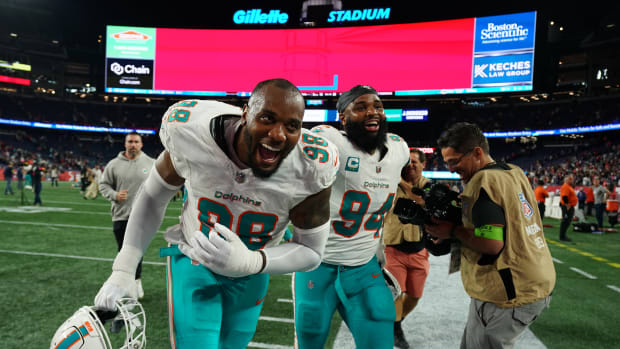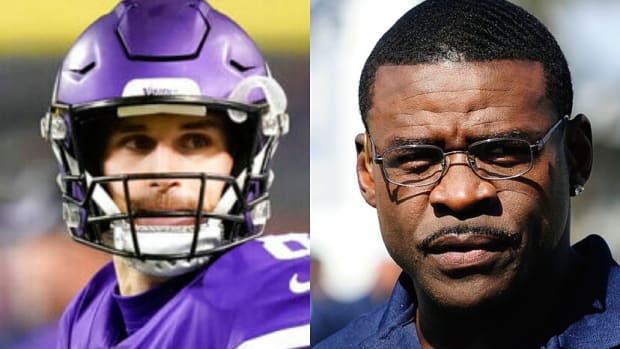The Best Athlete-Turned-Rapper? It’s Arian Foster. (Just Ask Him)
Arian Foster knows what you are thinking: Great, another athlete who wants to be a rapper…
The former All-Pro running back gets it. He even agrees. Athletes who have tried to rap have been, for the most part, terrible. There’s a stigma there, and it’s a fair one, and so Foster understands that you will have your preconceived notions about his post-playing career endeavors. All he’s asking is that you give his music an honest chance; that you listen with an open mind and a genuine ear. Because Foster not only believes he’s the best rapper of any athlete who has ever tried his hand at it; he’ll argue athletes aren’t even the group he should be getting compared to.
“I feel confident putting [my music] up against the greatest artists of our generation,” Foster says.
Foster, known professionally as Bobby Feeno, has reason for such bold proclamations. Put simply: His music is good. Not compared-to-Shaq-and-Kobe good. Genuinely good.
Last April, Foster independently released his debut album, Flamingo & Koval, and it was met with such a positive reaction within the industry that Mass Appeal Records, a label founded by hip-hop legend Nas, signed him to a two-project deal. Foster’s first release under his new label— a five-song EP titled A Late February—dropped on June 14; it’s currently available on all your usual music streaming services. Through both projects Foster has proven to be a thoughtful lyricist, with a smooth flow and an adept ear for composition. Every song on his new EP is raw and intimate, with each related thematically to the concept of love. “I am finding myself through my art,” he says. “It’s very personal.”
Yes, Foster is a rapper, but really he’s a musician, an artist; his music is an amalgamation of many styles, from hip-hop to funk to R&B, and every song incorporates some type of live instrumentation—horns, strings, drums, piano, guitar, bass. Foster credits his parents for his diverse style and eclectic taste; growing up in New Mexico, he was raised in a household filled with hundreds of vinyl records. His dad would spin Earth Wind & Fire and Con Funk Shun, while his mom was more into Patsy Cline and The Eagles. Foster prides himself that when he arrived at Tennessee, he could recite lyrics from George Strait songs and knew all the words to Garth Brook’s “The Thunder Rolls.”
“Music has always been the soundtrack of my life,” Foster says. “I fell in love with words.”
When Foster was 12, he frequented the website of poet and musician Saul Williams—one of Foster’s favorites—and scrolled through the site’s message board. There, fans would submit their own verse, and others would provide feedback. Foster had always jotted down his thoughts, had always fancied himself a writer of sorts, so he submitted some of his own work. His poems were more profound than you’d expect for an adolescent kid, not only detailing his family’s financial struggles but also taking simple concepts—like light, or love—and making them abstract and lyrical. The website’s community proved to be complimentary and supportive of his poems and encouraged him to continue to work at the craft.
“That’s when I started to realize I can write,” Foster says. “And I can write well.”
It’s worth noting now that a conversation with Foster—who was always one of the most fascinating interviews in the NFL over his eight-year career—is winding and discursive in the very best of ways, twisting and folding into various unexpected shapes like an origami figurine. If you have the time, Foster will happily discuss the books he is reading currently— from Albert Einstein’s Ideas and Opinions to Karl Marx’s Communist Manifesto. And the topic of his artistic origin story on the message board turns into a lament for what the Internet has become since those early days when Foster used it to find a supportive group of like-minded individuals who fueled his own passion and creativity.
“It’s like a snake swallowed itself,” Foster says of the Internet today. “Part of the beauty was the anonymity, the freedom you have on there. I think when it’s used not in a heinous way it can be very beautiful. You can find communion and at the end of the day that’s what we are all searching for.”
After hearing such a sentiment, one might say that Foster doesn’t sound like your typical NFL player. But Foster would take great offense to that. When he played, he hated when strangers added “attributes and baggage” to him before they even met him simply because he was an athlete—for instance, when he’d frequently be told that he was “articulate” upon meeting someone new.
“What the f--- does that even mean?” Foster asks. “That means in your head I’m not supposed to be. You’d never go to a politician and say, oh man, you’re articulate. That means I have to climb all of these mental hurdles from people before we are even conversing.”
(During his playing career Foster was so averse to people knowing he played in the NFL that when fans recognized him he’d respond that actually he was a chess player, not Arian Foster.)
Foster doesn’t believe that other athletes who attempted rap careers failed because they lacked the ability, but rather because they didn’t put in the time. Here he references Malcolm Gladwell’s 10,000-hour rule and argues that’s the main reason he is better than all of those ill-fated others. “I take this seriously,” Foster says. “Nights and years and years of just writing. Days and days of staying up and working.”
Foster began recording songs when he was in middle school—with early influences coming from East Coast hip-hop artists like Talib Kweli and Mos Def. As he got older and the technology improved he began to dabble with FruityLoops, a computer program that allowed users to create their own beats. When Foster got to college at Tennessee he used his $1,900 Pell Grant to buy a computer, a microphone and the digital audio production software known as Acid 5.0. He continued to record songs—thousands, he says—and found inspiration now from West Coast rappers like Tupac and The Game. His teammates would often appear on his tracks, and so Foster’s room at school was known as the Boom Boom Room.
When Foster arrived in the NFL in 2007 as an undrafted free agent on the Texans, he was forced to take the stage during training camp for a talent show of sorts, like most rookies do—one of the more innocuous examples of rookie hazing. While other players might do magic shows or stand up routines, oftentimes ending up being booed off the stage, Foster performed a rap song that he wrote specifically for the event. He spit bars about Gary Kubiak, the team’s coach, and even had a line that incorporated the team’s blitz pickups. By the end of the show some of Houston’s sexagenarian coaches standing in the back of their room had their arms raised, swaying to the flow. “It was a really dope moment,” Foster says.
As Foster’s career progressed to unforeseen heights—four Pro Bowl appearances, a league-leading 1,616 rushing yards in 2010, a contract extension that garnered him $20.75 million guaranteed in ’12—he began passing some of the music he had recorded around the locker room. His teammates told him that not only was his music good, but they would actually bump it even if he weren’t a friend, that it deserved to be played alongside the Kendrick Lamars and Drakes of the world. That gave Foster the confidence that he might be as good as he always believed he was. But he knew he couldn’t release a project when he was still playing; he wouldn’t be able to “give it the love, the energy, the time it needed.” If he was going to do it, he was going to do it right.
So when Foster retired four games into the 2016 season, the plan went into motion. He created the stage name Bobby Feeno—Bobby after Don’t Worry Be Happy singer Bobby McFerrin, and Feeno just because he thought it sounded cool—and began to put together an album. He knew he didn’t have to worry about making music to become famous or for financial gain, that he could do it simply for the love and for the art; that gave him freedom to explore his true emotions. And Foster knew that no one was expecting a music release from him, so he could take his time to perfect it.
He wrote the music— he had taught himself to play piano when he was in the NFL—and hired musicians to provide live instrumentation. Some songs went through upwards of eight revisions until he achieved the quality that met his standards. The ensuing album might not have been a commercial success, but it instantly earned Foster the sobriquet of being the best athlete rapper of all time.
His breakout track “A Friend a Fan a Kid” tells the narrative of Foster’s experience as an athlete through three perspectives, detailing his relationship with friends who felt he owed them something, with fans who felt they owned him, and with his family who missed him because he was always on the road. “As humbly as possible,” Foster says, “it’s the greatest song ever written by an athlete.” The album garnered him praise from rappers such as Scarface and Bun B, and Grammy-winning producers 9th Wonder and Hit-Boy. It also earned him the record deal.
“I am very appreciative of [the praise],” Foster says, “but it doesn’t surprise me, because I’ve put in so much work.”
Again, Foster believes that’s what distinguishes him from all of the other athletes-turned-rappers. Not that he faults them for trying. He doesn’t like the stigma in society that comes with rap music today, the dismissive belief that everyone wants to be a rapper. Everyone in the ’50s had a doo-wop group, Foster says, and in the ’70s they were in a rock band. “I think people should be able to express themselves at all times,” he says. “Everybody in every era is looking for some way to express themselves.”
Still, Foster notes: “There is nothing people hate more in this society than ex-athletes and rappers. And my dumbass chose to do both.”
Foster knows he is still growing as a musician. He believes that his most recent EP release, A Late February—so named because it was supposed to drop on Valentine’s Day but was delayed for four months—is more cultivated than his first album. The five songs on the album are connected thematically around the concept of love, ranging from one track (“Scarlet Letter”) that describes his experience cheating on a significant other to another (“Ms. Carry”) that’s about his college experience dealing with a partner’s miscarriage.
“I am finding myself through my art and I am expressing the things that I have been through,” Foster says. “I am not trying to portray an image, I’m not trying to be a rapper. I’m trying to express myself in art.”
He’s not naïve enough to think that everyone who listens will like his music. But he believes that if you’re willing to look beyond perception and presumptions, you’ll at least be able to appreciate the work he put into the music. The laboring he has done over the hi-hat placement and the kick drum sound, the studying he has done of chord progression and melodies. And for people who enjoy quality music in the genre, Foster knows they’ll get something, feel something, through his work.
“I put in my time,” Foster says. “And I think if anybody gives it an honest listen they’ll hear that.”
Question or comment? Email us at talkback@themmqb.com.





































